|
Last month I discussed one of the four
subfamilies of Pomacentridae, the always-lovable Clownfishes.
For November, I figured I'd keep going with this theme and
cover a second subfamily of Pomacentridae, Chrominae, or the
Chromis. Few members of this genus are regularly imported
for the marine aquarium trade, despite their overall vast
numbers and species in the wild. Most often, hobbyists purchase
these fish in large numbers to replicate schools or harems,
but should it always be this way? Join me in the November
edition of 'Fish Tales' as I explore the world of the Chromis.
Chromis verater (above & below)
is one of the largest Chromis,
and is endemic to Hawaiian waters. Photos courtesy of Keoki
Stender.
Meet the Family
One of the 28 genera of Pomacentridae is
Chrominae. Chromis are members of the subfamily Chrominae,
which contains a total of four genera (see below). In the
early 1900's, however, some disagreement persisted. Fowler
(1918) described the first subgenus of Chromis, Hoplochromis.
In addition, Fowler and Bean (1928) went a step further in
naming two additional subgenera, Lepidochromis and
Dorychromis. Most authors have largely ignored these
three subgenera, including Norman (1957). Fowler was not finished,
however, and in 1941 he described the genera Pycnochromis
and Thrissochromis followed by Serrichromis
and Lepicephalochromis (1943) and Siphonochromis
(1946). None of these genera are recognized today; all have
been regarded as synonyms of Chromis, but further research
of molecular phylogenetic evidence may yield the need for
recognized subgenera, which in that case it is likely that
some or all of Fowler's five described genera would be used
at the subgenus level (Randall and Swerdloff, 1973).
|
Genera of the Subfamily
Chrominae
|
|
Acanthochromis
|
Azurina
|
|
Chromis
|
Dascyllus
|
Chromis is a rather large genus, the largest
of Pomacentridae, with 86 described species (see below). They
are distinguished from other Damsels in a number of ways,
most notably by having a forked caudal fin, small conical
teeth with an enlarged front row, and a fully scaled head
except for around the mouth and nostrils. In addition, nearly
all the species have two or three projecting spiniform procurrent
caudal rays (Randall and Swerdloff,
1973).
| §
abrupta |
§
abyssicola |
| §
acares |
| §
agilis |
| §
albomaculata |
| §
alleni |
| §
alpha |
| §
alta |
| §
amboinensis |
| §
analis |
| §
atrilobata |
| §
atripectoralis |
| §
atripes |
| §
bami |
| §
bicolor |
| §
cadenati |
| §
cauruleus |
| §
caudalis |
| §
cautus |
| §
chromis |
| §
chrysura |
| §
cinerascens |
| §
crusma |
| §
cyanea |
| §
dasygenys |
| §
delta |
| §
dimidiate |
| §
dispilus |
| §
elerae |
| §
enchrysura |
| §
fatuhivae |
| §
flavapicis |
| §
flavaxilla |
| §
flavicauda |
| §
flavipectoralis |
| §
flavomaculata |
| §
fumea |
| §
fuscomaculatus |
| §
hanui |
| §
hypsilepis |
| §
insolata |
| §
intercrusma |
|
| §
iomelas |
§
jubauna |
| §
klunzingeri |
| §
lepidolepis |
| §
leucura |
| §
limbata |
| §
limbaughi |
| §
lineata |
| §
lubbocki |
| §
margaritifer |
| §
megalopsis |
| §
meridiana |
| §
mirationis |
| §
multilineata |
| §
nigroanalis |
| §
nigrura |
| §
nitida |
| §
notata |
| §
okamurai |
| §
opercularis |
| §
ovalis |
| §
ovatiformis |
| §
pamae |
| §
pelloura |
| §
pembae |
| §
punctipinnis |
| §
randalli |
| §
retrofasciata |
| §
sanctaehelenae |
| §
scotochiloptera |
| §
scotti |
| §
struhsakeri |
| §
ternatensis |
| §
trialpha |
| §
vanderbiliti |
| §
verater |
| §
viridis |
| §
weberi |
| §
westaustralis |
| §
woodsi |
| §
xanthochira |
| §
xanthopterygia |
| §
xanthura |
| §
xutha |
|
|
In the Wild
Distribution of Chromis is nearly
worldwide in tropical or subtropical seas. From Hawaii to
the Red Sea, the Philippines to the Florida Keys, if there
is a warm water reef, chances are very good that Chromis
can be found nearby. In fact, chances are good that Chromis
will also be the most numerous fish present on a given reef.
Chromis multilineata and C. cyanea are referred
to as the Caribbean's "most abundant reef fish"
(DeLoach, 1999) and C. viridis as "one of the
most abundant reef fish" (Randall, 1985). The depths
at which they can be found are highly variable. Most species
are found between the 40 to 100 feet range, but some species
extend well out of this "normal" range. Species
can be located on coral reef heads in only 10 - 15 feet of
water (C. vanderbiliti), while others are plentiful
below 400 feet (C. analis). If I had to sum up this
paragraph in a single sentence, it would be, "Chromis
species are extremely numerous most anywhere a coral reef
occurs."
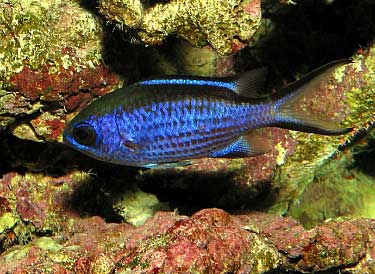 |
A very attractive Atlantic species of Chromis is C.
cyanea, also
called the Blue Chromis. This photo was taken of an aquarium
resident. Photo courtesy of Greg Rothschild.
Most Chromis are located along steep
reef slopes and drop-offs with strong water currents where
they swim several feet above the coral heads, generally facing
the current, and feeding upon zooplankton. The brisk water
movement provides an endless supply of their favorite food,
zooplankton. The term "zooplankton" can mean a lot
of things, but for Chromis, this is generally defined
as copepods (up to 60% of the diet), malacostracan larvae
(up to 10%), pelagic tunicates (up to 17%), larval polychaetes
(2%) and fish eggs (less than 1%) (Randall and Swerdloff,
1973; 1989).
Chromis agilis is located in Hawaiian waters often
associated with C. hanui, though C. agilis can
also
be located throughout much of the Indo-Pacific where it prefers
the leeward sides of islands.
Photos courtesy of Keoki Stender.
When predators threaten, the Chromis
will disappear in a flash into the coral heads, remaining
tucked tightly into the crevices until the perceived danger
is no longer present. Other than their schooling behavior
and its benefit of "safety in numbers," this is
their only means of defense. Although most members will also
spend the evening buried into these same coral heads, some
species (C. ovalis) will simply lie upon the substrate
and adapt a coloration that blends with the sand, most often
a mottled gray.
The overall numbers can be confusing to
some hobbyists as well. Although "schooling" by
large numbers of Chromis is something that can occur
regularly, mostly by juvenile fish, this should not be considered
commonplace for all adult Chromis. Many, but not all,
species prefer to maintain a nest occupied by only themselves
or with a small harem of females. Due to the small territories
they claim and with their passive nature, unlike most damsels,
feeding is done in the close vicinity of their cohorts. Aggregations
of these harems, coupled with their profuse abundance on the
reef, and their overlapping territories, can easily be confused
as a single large school of Chromis. If watched
closely, however, members will remain close to the same location,
usually within a radius of several meters of their nesting
area, and associate primarily with the same members of their
harem, even as they forage for food in the water column. When
individuals do stray far from home, however, it is always
done under the cover of a large school for the purpose of
feeding. Schools are a safer option than going at it alone
when traveling great distances, and schools can easily overrun
single or paired specimens when competing for new feeding
grounds. For the species that typically school for the majority
of their existence, such as C. atripectoralis and C.
viridis, neither nests nor territories are maintained.
The only exception to this rule is when spawning occurs. Males
of both the schooling species and non-schooling species have
similar spawning tendencies (more on this below).
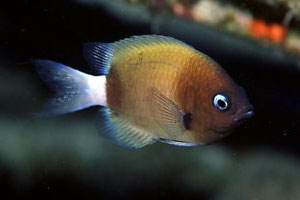 |
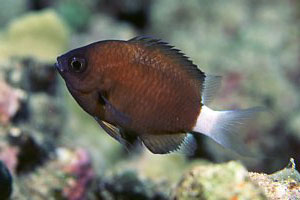 |
Chromis hanui, another endemic of Hawaiian waters,
is perhaps the most secretive of Chromis,
rarely venturing further than several feet away from protective
crevices.
Photos courtesy of Keoki Stender.
Coloration in juveniles can vary sharply
from that of adults of the same species. For example, Chromis
ovalis has three described colorations which originally
were the subject of confusion for ichthyologists attempting
to classify this species. Chromis ovalis outgrows its
juvenile coloration when reaching a size of between 30mm and
60mm, and then sheds its second coloration for its final adult
coloration as it reaches sexual maturity around 95mm of total
length (see photos below).
For comparison, 120mm is considered full grown for this species,
although specimens reaching 153mm have been reported.
Sexual dichromatism is present for many
species during courtship and spawning only. For species such
as Chromis cyanea this results in males darkening their
back and sides to a much greater extent than normally present,
while the females are noted to turn nearly entirely black.
Sexual dimorphism is also present, but not obvious, as the
males are only slightly larger than females.
Spawning behavior usually follows one
of two patterns. The most common pattern is a single male
spawning with a single female. In this instance, males will
prepare the nest site by fanning away sand, detritus, and
other debris from algae brush, gorgonians, or rock crevices.
Unlike most fish, which use their caudal fin to fan away debris,
Chromis utilize a fast beating of their pectoral fins
to accomplish this feat. The male will attempt to mate with
each female of its harem, usually displaying their mating
dance to the entire harem. They employ a rather simplistic
mating ritual, one where the male makes short, vertical bursts
of about three feet, repeating frequently. This is always
followed by nipping at the fins of the females until the females
are coaxed into the nest of the male. Although the male may
display to several females at once, only one at a time will
enter and lay eggs. In most cases, the male waits until the
female is finished attaching her eggs to the chosen algae,
gorgonian, or rock crevice before he follows behind and fertilizes
the eggs.
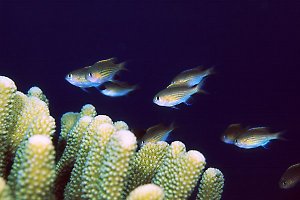 |
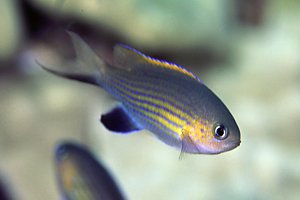 |
The highly sought after C. vanderbiliti is seen here.
Despite the wonderful photograph,
Vanderbilt's Chromis is significantly more impressive in person.
Photos courtesy of Keoki Stender.
The second type of spawning event is less
frequently seen, occurring only once per lunar cycle and in
areas with high densities of Chromis. For two or three
days preceding the event, large adult males will begin nest-building
activities on an open sand bottom. On the morning of day three,
the adult females have joined the males and with a few traditional
spawning jumps, a five or six hour spawning event occurs.
This event can include several thousand individuals.
The males guard the fertilized eggs, and
this is the lone time that Chromis can become aggressive.
Males will often confront potential egg thieves several meters
above the nest in an attempt to ward off the intruder. When
several intruders approach at once, males will remain defiant
and motionless in the typical head down position just above
or at the entrance of their nest. As is expected, males will
also fan the demersal eggs to remove settling debris and provide
aeration, as well as remove unfertilized or fungal infected
eggs. Within three days, the eggs hatch and become planktonic
larvae for three or four weeks before the newly settled juveniles
seek out security in the crevices of the rockwork.
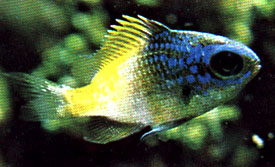 |
Another really attractive Chromis is Limbugh's
Chromis, aka C. limbaughi. These individuals
can be located around the Mexican Baja and Sea of Cortez.
A juvenile is seen here. Photo courtesy of Alex Kerstitch
and University of Arizona Collections.
|
In the Home Aquarium
Provided a few basic needs are met, Chromis
can be kept in the home aquarium rather successfully. Unlike
their cousins, the damsels, who generally dictate the need
for aggressive tankmates, Chromis are the exact opposite.
Tankmates that would be required for other Pomacentridae would
undoubtedly pester or harass Chromis. In fact, these
damsels will do best in an aquarium where they are the dominant
member(s) with a few other less aggressive species in the
same tank. They will flourish if large fish, such as adult
angels or surgeonfish, are not present. The presence of the
larger fish will not necessarily doom the Chromis,
but it will make them work harder to obtain enough food, and
will likely discourage natural shoaling with the Chromis
instead opting to remain closer to the rockwork. When choosing
suitable tankmates, predatory fish (see below) and predatory
invertebrates, such as Ophiarachna
species, should be avoided as Chromis can make an easy
target. Chromis will not harm corals or mobile invertebrates.
Compatibility
chart for Chromis:
|
Fish
|
Will Co-Exist
|
May Co-Exist
|
Will Not Co-Exist
|
Notes
|
|
Angels, Dwarf
|
X
|
|
|
Good choice.
|
|
Angels, Large
|
|
X
|
|
Some large angels are too aggressive to share an aquarium
with Chromis.
|
|
Anthias
|
|
|
X
|
Food competitors. Both share open water column.
|
|
Assessors
|
X
|
|
|
Good choice.
|
|
Basses
|
X
|
|
|
Good choice.
|
|
Batfish
|
X
|
|
|
Good choice.
|
|
Blennies
|
X
|
|
|
Good choice.
|
|
Boxfishes
|
X
|
|
|
Good choice.
|
|
Butterflies
|
X
|
|
|
Good choice.
|
|
Cardinals
|
X
|
|
|
Good choice.
|
|
Catfish
|
|
X
|
|
Adults may consume Chromis.
|
|
Comet
|
X
|
|
|
Good choice.
|
|
Cowfish
|
X
|
|
|
Good choice.
|
|
Damsels
|
|
X
|
|
Some damsels are too aggressive to share an aquarium
with Chromis.
|
|
Dottybacks
|
|
X
|
|
Some dottybacks are too aggressive to share an aquarium
with Chromis.
|
|
Dragonets
|
X
|
|
|
Good choice.
|
|
Drums
|
X
|
|
|
Good choice.
|
|
Eels
|
|
|
X
|
Adults may consume Chromis.
|
|
Filefish
|
X
|
|
|
Good choice.
|
|
Frogfish
|
|
|
X
|
Adults may consume Chromis.
|
|
Goatfish
|
X
|
|
|
Good choice.
|
|
Gobies
|
X
|
|
|
Good choice.
|
|
Grammas
|
X
|
|
|
Good choice.
|
|
Groupers
|
|
|
X
|
Adults may consume Chromis.
|
|
Hamlets
|
|
|
X
|
Natural predator of juvenile Chromis.
|
|
Hawkfish
|
X
|
|
|
Good choice.
|
|
Jawfish
|
X
|
|
|
Good choice.
|
|
Lionfish
|
|
|
X
|
Adults may consume Chromis.
|
|
Parrotfish
|
|
X
|
|
Most Parrotfish will become too large for Chromis
to feel comfortable.
|
|
Pineapple Fish
|
X
|
|
|
Good choice.
|
|
Pipefish
|
|
|
X
|
Pipefish require an aquarium unto themselves.
|
|
Puffers
|
|
X
|
|
Some Puffers are too aggressive to share an aquarium
with Chromis.
|
|
Rabbitfish
|
|
X
|
|
Most should mix well, but some Rabbitfish can become
aggressive over time.
|
|
Sand Perches
|
X
|
|
|
Good choice.
|
|
Scorpionfish
|
|
|
X
|
Adults may consume Chromis.
|
|
Seahorses
|
|
|
X
|
Seahorses require an aquarium unto themselves.
|
|
Snappers
|
|
|
X
|
Adults may consume Chromis.
|
|
Soapfishes
|
|
|
X
|
Adults may consume Chromis.
|
|
Soldierfish
|
|
|
X
|
Adults may consume Chromis.
|
|
Spinecheeks
|
X
|
|
|
Good choice.
|
|
Squirrelfish
|
|
|
X
|
Adults may consume Chromis.
|
|
Surgeonfish
|
|
X
|
|
Some Surgeonfish may become too aggressive for Chromis.
|
|
Sweetlips
|
|
|
X
|
Adults may consume Chromis.
|
|
Tilefish
|
X
|
|
|
Good choice.
|
|
Toadfish
|
|
|
X
|
Adults may consume Chromis.
|
|
Triggerfish
|
|
X
|
|
Most Triggerfish are too aggressive to share an aquarium
with Chromis.
|
|
Waspfish
|
|
|
X
|
Adults may consume Chromis.
|
|
Wrasses
|
|
X
|
|
Many wrasses will coexist very well, but some become
very aggressive as well.
|
Note: While many of the fish listed are
good tank mates for Chromis
species, you should research each fish individually before
adding it to your aquarium. Some of the fish mentioned are
better left in the ocean, or for advanced aquarists.
Food is another important consideration
for Chromis. They are active fish that are constantly
feeding in the wild. Their natural instinct to consume food
from the water column usually translates into a fish that
is eager to accept prepared foods. Aquarists can expect their
newly arrived Chromis to consume prepared foods in
only a day, or at the most three days, but this will most
likely occur within the same day they are added. Any prepared
foods geared towards a carnivorous marine fish will be a suitable
substitute for their natural diet. The type of food to feed
is easy; the quantity to feed is the more challenging question
to answer. A lot of the answer depends on the particular aquarium
in which the fish are present. Small aquariums or aquariums
that produce small amounts of planktonic life will require
more frequent feedings than larger aquariums or aquariums
that produce copious amounts of planktonic life. A safe median
to shoot for would be three feedings per day unless the aquarium
is supplying a portion of their diet.
|
Often confused with Chromis margaritifer, C.
pembae, and C. hanui is this C. leucurus.
All four species are very similar in coloration, though
C. leucurus is the most sought after thanks to
the blue edging around its eye.
Photo courtesy of Keoki Stender.
|
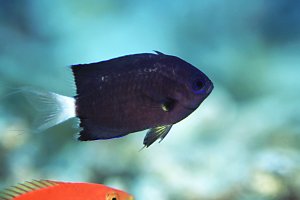 |
This column would not be complete without
including a paragraph regarding the often-debated topic of
aquarium size. When a single individual is kept they can usually
do well in aquariums as small as 40 gallons, assuming it shares
the aquarium with non-threatening fish.
Consider increasing the size of the aquarium if the
plan is for the Chromis to share the aquarium with
fish larger than itself. For the schooling species, a small
shoal of six to eight individuals can do well in the traditional
four feet long, 75 gallon aquarium, provided enough food is
available to the fish. Also consider that a shoal of this
size should be the focal point of the aquarium and the remaining
residents should be a less dominant species. Open water swimming
fish, like surgeonfish and large angels, should be avoided
in aquariums as small as the aforementioned 75 gallon aquariums
that house a shoal of Chromis.
Meet the Species
With 86 species to the genus' credit, I
surely cannot discuss each individual. Thankfully, only a
handful of species actually make it into the American market
for retail sale. Far and away the most popular species sold
in the trade is Chromis viridis, or the Blue/Green
Chromis. Actually, it would not surprise me if some readers
of this column just realized for the first time that there
are more Chromis than just the Blue/Green Chromis.
Many retail outlets rarely sell any other species. Confusion
existed for quite some time regarding the name of this species.
In addition to C. viridis, names such as Heliases
cauruleus, Chromis ternatensis and C. caerulea
were all used. Once the confusion was sorted, the original
name was determined to be derived from a hand painted, color
portrait by Ehrenberg in Cuvier (1830) (Randall, 1985). Chromis
viridis, possibly the most abundant reef fish, spends
the afternoon in large shoals above Acropora sp. in
areas stretching from the Red Sea and coast of East Africa
and across the entire Indo-Pacific range.
A fish often confused as C. viridis
is C. atripectoralis, or the Blackaxil Chromis. Although
they have been measured slightly larger than C. viridis
(4 ½" compared to C. viridis at 3 ½"),
they are nearly identical except for one determining factor.
Chromis atripectoralis has a black spot at the base
of each pectoral fin. This trait, of course, led to the Latin
name it was awarded.
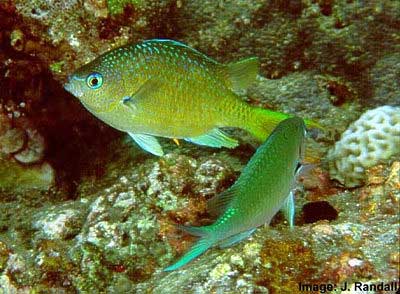 |
|
The two closely related species of C. viridis
(below) and C. atripectoralis (above)
are seen here. Chromis atripectoralis
can be easily distinguished by the small, but still
easily visible black spot at the base of the pectoral
fin. It is clearly visible in the above image. Photo
above courtesy of John Randall, photo below courtesy
of Lisa Page.
|
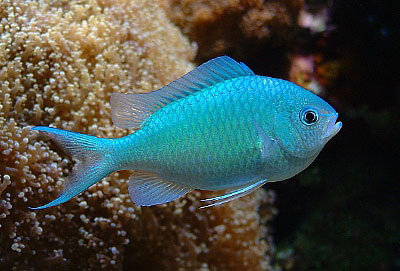 |
A popular Caribbean import for the hobby
is Chromis insolata, or the Olive Chromis. Juveniles
are magnificently colored, but as they age into adults, they
loose their remarkable coloration for a drab olive green color.
They are among the largest Chromis, reaching just over
five inches of total length.
The juvenile coloration of Chromis insolata. Adults
loose much of their striking
colors and become entirely one color; the same shade as the
underside
of the fish seen here. Photo by Henry C. Schultz III.
One of the more sought after Chromis
is C. vanderbiliti, or more commonly referred to as
Vanderbilt's Chromis.
It is rarely imported, although it does have a natural home
range covering most of the Central and Western Pacific, including
Hawaii. This species remains small, roughly two inches, and
can be less outgoing than other Chromis. Because of
this, it is best to keep this Chromis in small aggregations
in very peaceful aquariums. It prefers shallow water, often
less than 20 feet, where it feeds in mid water above large
coral heads. Chromis nigrurus is closely related, differing
only by having a yellow caudal fin edged with black, and the
anal and dorsal fin also edged with black.
Chromis ovalis, having the clever
common name of Oval Chromis, is also sometimes referred to
as C. velox. However, 23 publications have referred
to this species as C. ovalis compared to the four known
publications using C. velox, the last some 43 years
ago (Randall and Follett, 1989). This species is endemic to
the Hawaiian Islands, where it is found in small aggregations.
Spawning season is from February through May.
The Oval Chromis is seen here in all three color phases. The
juvenile is seen on the top left,
which progresses to the coloration found in the sub-adult
(top right), and finally
progresses to an adult seen on the bottom right.
Photos courtesy of Keoki Stender.
Conclusion
Many times over hobbyists receive Damselfish
as their first fish to place into a newly setup aquarium.
Oftentimes this is the first step backwards that a hobbyist
takes, as the belligerent personality of the damsel makes
it nearly impossible to add more fish in the future. Furthermore,
it's likely that the next step is this same damsel becoming
the first fish that the new hobbyist must try to capture -
a near impossible feat for even the most seasoned veteran.
Chromis, on the other hand, fit this 'first fish' niche
quite nicely. They are nearly as bulletproof as their cousins,
but arrive without the pugnacious attitude that is so common
in other damsels. They are equally as difficult to remove,
but as is most often the case, there is no need to remove
the Chromis. Supplying the correct type and amounts
of food, in conjunction with housing it with equally passive
tankmates, will help ensure their health for years to follow.
Acknowledgements
I would like to extend a special "thank
you" to Kevin Kocot for assisting in the collection of
the photographs for this column, as well as to all the photographers
who granted their permission of photo requests.
|

